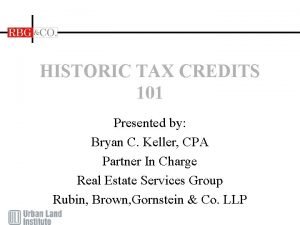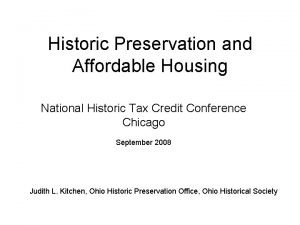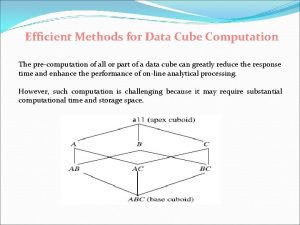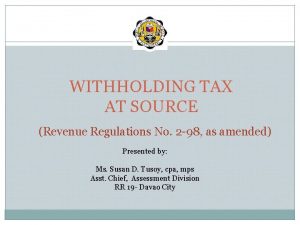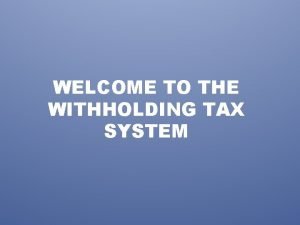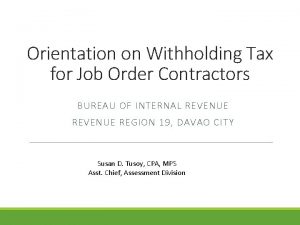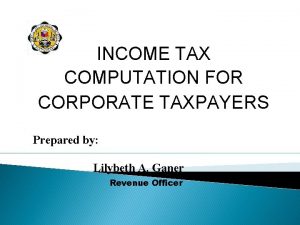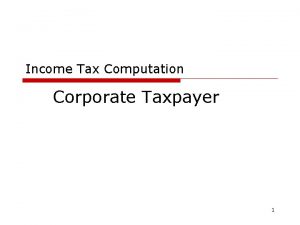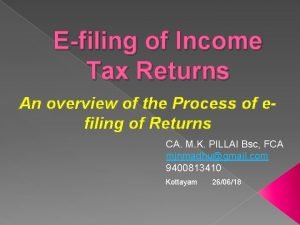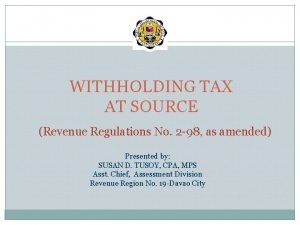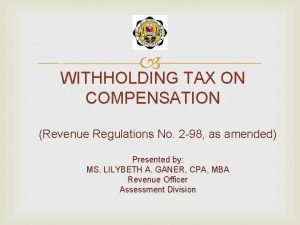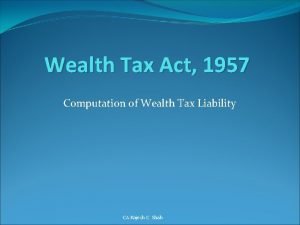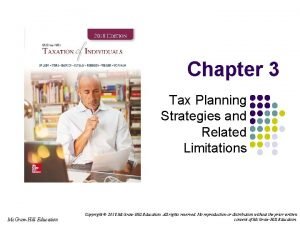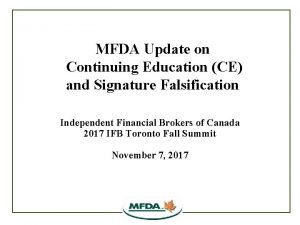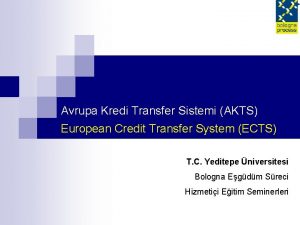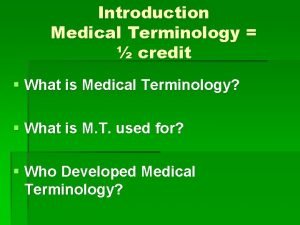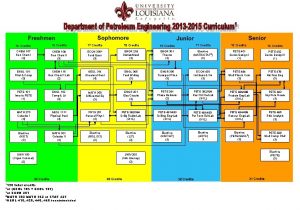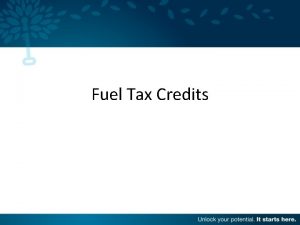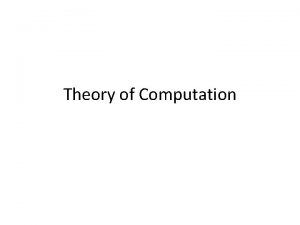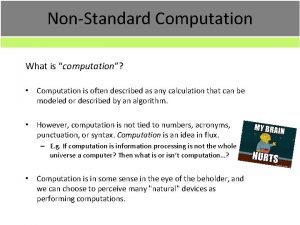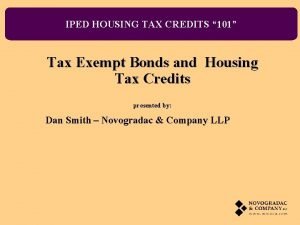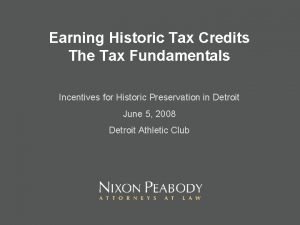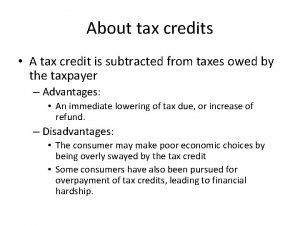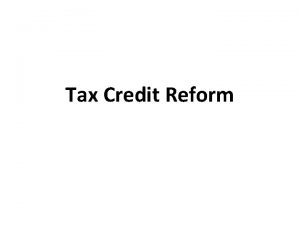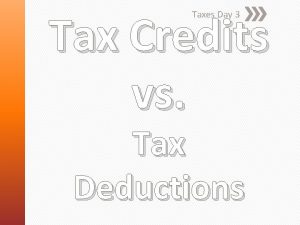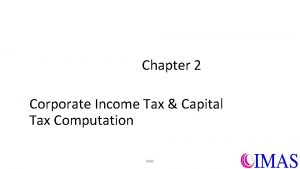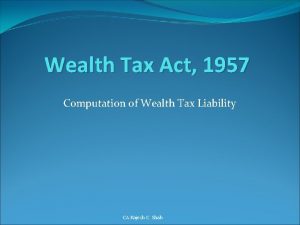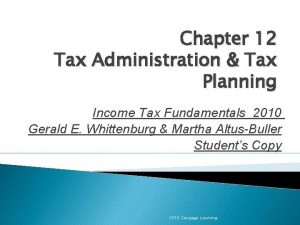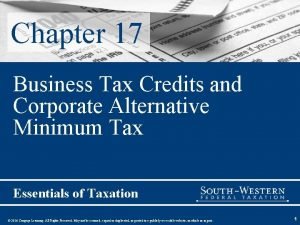Chapter 14 Special Tax Computation Methods Tax Credits























- Slides: 23

Chapter 14 Special Tax Computation Methods, Tax Credits, and Payment of Tax

Learning Objectives • Calculate the Alternative Minimum Tax • Describe what constitutes selfemployment income and compute the selfemployment tax • Describe the various business and personal tax credits • Understand the mechanics of the federal withholding tax system and the requirements for making estimated payments

Alternative Minimum Tax COMPUTATIONAL ASPECTS TAXABLE INCOME PLUS+: TAX PREFERENCE ITEMS PLUS+: PERSONAL AND DEPENDENCY EXEMPTION PLUS+ OR MINUS: ADJUSTMENTS REQUIRED EQUALS =: ALTERNATIVE MINIMUM TAXABLE INCOME MINUS: EXEMPTION AMOUNT ($45, 000 MFJ & SS, $33, 750 single, & $22, 500 MFS) EQUALS =: ALTERNATIVE TAX BASE TIMES x: TAX RATE (26% of first $175, 000; 28% amounts in excess of $175, 000) EQUALS =: TENTATIVE MINIMUM TAX MINUS: REGULAR TAX EQUALS =: THE ALTERNATIVE MINIMUM TAX

Alternative Minimum Tax • Tax preference items – Include excess depreciation over SL depreciation – Tax-exempt interest on certain activity bonds – Exclusion of gain on the sale of certain small business stock under Sec. 1202

Alternative Minimum Tax • AMT adjustments – – For most taxpayer AMTI adjustments represent itemized deductions that are not allowed in computing AMTI Only certain itemized deductions allowed for AMT purposes • Casualty and theft loss in excess of 10% of AGI • Charitable contributions • Medical expenses in excess of 10% of AGI • Qualified housing interest

Alternative Minimum Tax • AMT adjustments due to timing differences – For real property placed in service after 1986, difference between MACRS and ADS

Alternative Minimum Tax • AMT adjustments due to timing differences – For personal property placed in service after 1986, difference between MACRS deduction and the amount determined by using 150% DB method

Self-employment Tax • Distinction between independent contractor and an employee is important • Self-employed individuals are subject to self-employment tax on the amount of net earnings from the selfemployment • Employees who have a small business in addition to regular employment may also be subject to the selfemployment tax

Self-employment Tax • Computing the tax – – Individuals having net earnings from selfemployment of $400 or more are subject to the self-employment tax The self-employment tax is 15. 3%. This consist of 12. 4% for OASDI and 2. 9% for Medicare. The limit for 2004 on OASDI is $87, 900 and there is no limit on the Medicare portion of the self-employment tax

Self-employment Tax • Computing amount subject to the self-employment tax – To compute the amount that is subject to selfemployment tax. Multiply self-employment income by 92. 35% (100%-7. 65%) this equals the net earnings from selfemployment

Self-employment Tax – One-half of selfemployment tax imposed is allowed as a for AGI deduction

Self-employment Tax • What constitutes selfemployment – – Net earnings from a sole proprietorship Director’s fees Taxable research grant Distributive share of partnership income plus guaranteed payments • The self-employment tax is computed on Schedule SE

Overview Of Tax Credits • Use and importance of tax credits – Tax credits may be used to implement tax policy objectives • Example: provide tax relief for low income taxpayer earned income credit

Overview Of Tax Credits • Value of credit versus a deduction – The value of a deduction is dependent on taxpayer’s marginal rate – A tax credit reduces tax liability dollar for dollar

Overview Of Credits • Classification of credits – Refundable – Nonrefundable

Overview Of Tax Credits Non-refundable • Personal tax credits • Child tax credit • Child and dependent care credit • Tax credit for the elderly & disabled • Adoption credit • Hope scholarship credit • Lifetime learning credit • Qualified Retirement Savings Contribution Credit

Overview Of Tax Credits Non-refundable • Miscellaneous credits – Foreign tax credit • General business credits – Credit for increasing research – Work opportunity credit – Empowerment zone employment – Disabled access credit – Rehabilitation expenditures – Business energy credit – Welfare to Work

Refundable Credits • Earned Income Credit • Eligibility rules: – Earned income and AGI thresholds met – Principal place of abode in the US for more than ½ of the tax year. – The individual is at least 25 years old and not more than 64 at the end of the year. – The individual is not a dependent of another taxpayer for the tax year

Payment Of Taxes • Withholding of taxes – – – Employers are required to withhold federal income taxes and FICA tax from employee compensation Special rules are provided for more than one employer during the same year Exemptions for certain employment activities such as ministers and domestic servants

Payment Of Taxes • Withholding allowances and methods – Every employee must file an Employee’s Withholding Allowance Certificate (Form W-4)

Payments Of Taxes • Estimated tax payments – Calendar year taxpayers quarterly payments are due April 15, June 15, Sept 15 of the current year, and January 15 of the following year

Tax Planning Considerations • Avoiding the Alternative Minimum Tax • Avoiding the underpayment penalty for estimated tax • Cash-flow considerations • Use of credits

Compliance And Procedural Considerations • Alternative minimum tax filing procedures Form 6251 or 4626 • Withholding and estimated payments Form W-2 and 1040 ES • General Business Credit Form 3800 • Personal tax credits – Form 2441 – Schedule R – Schedule EIC – Form 1116 – Form 8863
 Historic tax credits 101
Historic tax credits 101 Historic tax credits 101
Historic tax credits 101 Charlie werhane
Charlie werhane New market tax credits 101
New market tax credits 101 Historic tax credits 101
Historic tax credits 101 The plaza apartments toledo ohio
The plaza apartments toledo ohio Data cube computation methods
Data cube computation methods Expanded withholding tax computation
Expanded withholding tax computation Expanded withholding tax computation
Expanded withholding tax computation Job order tax
Job order tax Personal income tax computation
Personal income tax computation Income tax computation format
Income tax computation format Income tax computation format
Income tax computation format Expanded withholding tax revenue regulation
Expanded withholding tax revenue regulation W/tax compensation table
W/tax compensation table Net maintainable rent
Net maintainable rent Indirect methods of contoring uses how many methods
Indirect methods of contoring uses how many methods 8 methods of tax attorney domination - indorecipe
8 methods of tax attorney domination - indorecipe Georgijev financial group
Georgijev financial group John tyler cc
John tyler cc Ects grade
Ects grade Akts nedir
Akts nedir Uncc soar
Uncc soar Credits medical definition
Credits medical definition
